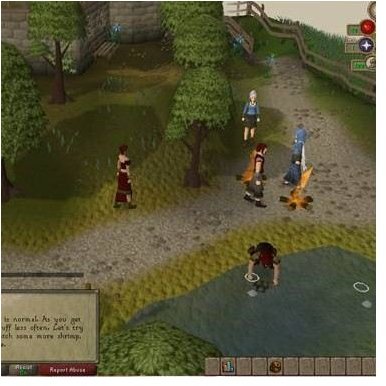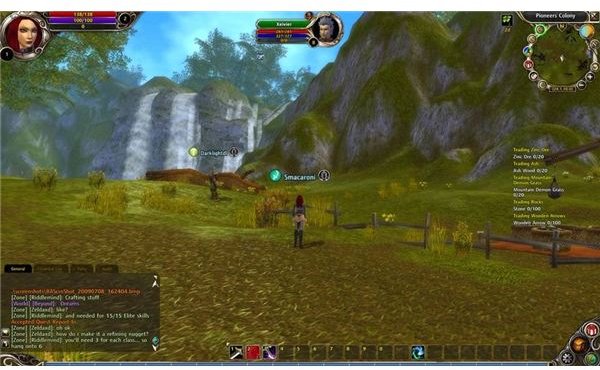Free to Play MMOs

Online Gaming
Collaborating online with one’s friends has become a pretty popular hobby in video gaming. While the major consoles offer their own formulas and mechanics for hooking gamers up with their buds and introducing them to other gamers who might be currently playing the same thing, computer gaming has been doing the ‘online’ thing since way before it was cool. Of course, one of the biggest venues for this type of game is the MMO, most of which we require purchase of an account and a montly subscription fee.
Free to Play MMOs - The Beginning
Runescape: Introduced in 2001, [Runescape](https://www.alteredgamer.com/runescape/40633-the-slayer-guide-make-money-while-leveling-1-99/)'s websites boasts that it is the World's Most Popular Free MMO. Delivering its content within a web browser eliminates the need to download an application, which makes the game even more accessible. Free accounts are available, but those who pay the $5.95 monthly fee will have access to more weapons, skills, areas, and quests.
- MapleStory: Similar in execution is this little gem of a game; introduced in 2003, it is still going strong with its action RPG and fantasy elements. While Maplestory does not offer an ‘upgrade’ account option, there are items and gameplay enhancements available for purchase with real-world currency. Many players insist that not paying for these bonus features is a hindrance and consider them mandatory for a good gaming experience.
- Second Life: Not so much a game as it is an alternate and virtual world, Second Life is an absorbing and experience. While the basic accounts are free to play, converting real-life money into game currency allows the players to form an actual economy in-game. Avatars can accept employment, start their own business, and sell goods and services to other players. The upshot here is that it is entirely possible to show a net profit.
F2P MMO for the Kids

Two of the more recent Free-to-Play MMOs are Free Realms and Runes of Magic. Free Realms is a 3D adventure that appeals to a far-reaching crowd of players. With an ESRB rating of ‘E’ and marketing to a younger audience, this game has garnered quite a bit of attention since its release in April of 2009. Players can choose either gender of a human or pixie avatar, and because the game is browser-based, there is no purchase of software involved.
Instead of classes, characters take one of several jobs and complete quests and mini-games to level up. A charming, kid-friendly interface and tutorial make this a great choice for those who aren’t yet ready for a more sophisticated game. Basic accounts are free, while the publisher does offer a subscription alternative for $4.95 per month. Paid accounts have the ability to create 2 additional characters, be ranked on leader-boards, and get access to more quests, items, and jobs. Additional currency is in the form of Station Cash, which can be purchased via credit card and other methods from the Free Realms website. Station Cash can be used for items in-game and many consider a healthy Station-Cash account a must-have for maximum enjoyment.
Is it Runes of Magic, or WoW-Lite?

The most recent of its kind to make the MMO scene, Runes of Magic has been compared to World of Warcraft - and rightly so. Just one glance at the user interface and it’s easy to see the basis for this observation. Right down to the fonts used, the creators’ fondness for the MMO giant is immediately evident. Instead of focusing on the similarities, however, it may be more helpful to look at RoM’s different attributes. Digging into this game will show the influences that Everquest, Dungeons and Dragons, and other games have had on it.
The class system begins much most other RPGs, but at level 10 characters are able to select a secondary class. When well-planned, this secondary class can enhance and complement the primary class a great deal. For instance, a Warrior who takes the Priest secondary can evolve into somewhat of a Paladin, with heavy armor and the ability to heal himself. Other class combinations work similarly and contribute a great deal to individuality and character customization.
Also in Runes of Magic, real life currency can purchase in-game Diamonds, which are then used to buy items, equipment, and “encyclopedias.” These manuals teach the character various tradeskills. Buying a mount, changing a character’s hair style, and other luxuries are about the only things players can spend these Diamonds on. At this point, it does not seem likely that anything purchased from the Item Shop would be of use to PvPers, and so the argument against extraneous currency in a F2P game would seem to have little weight here.
So this is free?

There is little doubt that a market for new and interesting MMOs exists, and that a section of this market is primarily interested in games that do not require a monthly fee or up-front account purchase. Choosing a F2P MMO gives the player flexibility in choosing when to purchase extras, and allows him or her to avoid being hit with an automatically recurring monthly fee. When work, school, or other responsibilities limit gaming time, choosing one of these titles allows the gamer to pay only when they are playing.
Innovation in mechanics, graphics, and character-building benefit not just all players, but also the games that are currently still in the concept phase. As long as the F2P player-base exists, developers will continue to expand on this market and gamers as a whole can expect to see some really interesting additions to the genre. Games like MapleStory and Runes of Magic are offering up a new playing field, and while it is, of course, possible to spend more on vanity items than one might for a monthly subscription, at least those expenditures are discretionary.
